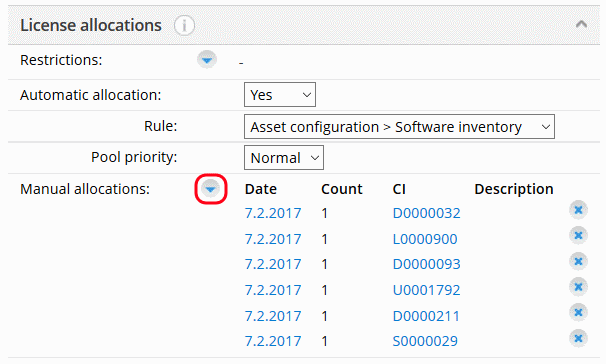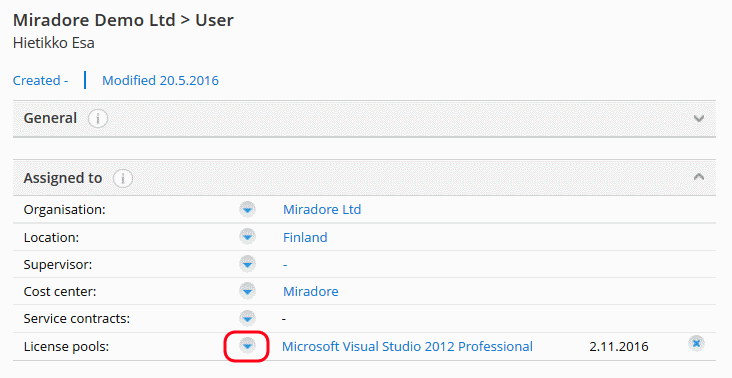About license allocation
Miradore license management provides an easy way to ensure the compliance of your software licenses by providing a possibility to automatize majority of allocation and removal of acquired licenses. In addition to automatic allocation of licenses, the licenses can also be allocated to and released from assets or users manually. Miradore license management offers support for a variety of different licensing models.
Licensing models
The following table presents different licensing models and describes how they are supported in Miradore.
Model |
Support for automatic allocation |
Support for manual allocation |
Description |
Concurrent users |
- |
Yes |
This type of license permits only certain amount of users to use the software concurrently. |
Named users |
Yes |
Yes |
License based on named users is user specific, which means that the user can install the licensed software into all assets whose responsible person he is and only one license is required. In other words, the user is able to use the same software on multiple assets. |
Installed instance |
Yes |
Yes |
A license is needed for each instance of software installation separately. This licensing model is asset specific. |
Physical server |
- |
Yes |
In this case, the license permits to use the software on certain server only. |
Physical CPU |
- |
Yes |
In this case, the license permits to use the software on certain CPU only. |
How to allocate/release licenses manually
Through the license pool items, you can allocate and release software licenses for the selected users or devices in Miradore. If you leave the asset/user undefined, licenses are assigned to users or devices that are not managed with Miradore Management Suite.
![]()
![]() Picture: You can manage
manual license allocations in the Manual
allocations field at the License
pool item.
Picture: You can manage
manual license allocations in the Manual
allocations field at the License
pool item.

Alternatively, you can do the same thing also the other way around, by opening the User or Asset item for which you want to assign the license, and selecting the desired license pools to the License pools field.
![]()
![]() Picture: You can tie
user and asset configuration items to license pools.
Picture: You can tie
user and asset configuration items to license pools.

Automatic allocation
Miradore supports automatic allocation of software licenses on two commonly used licensing models. The automatic allocation of licenses is based on rules defined on each license pool separately. The licenses are also allocated automatically when a software package including managed software that requires a license is distributed to assets. See the Automatic allocation of licenses page for further information.
Restrictions
Restrictions are used to set constraints for the allowed use of the license pool. The use of license pool may be restricted to certain asset group, location, organisation, user, contract, or cost center. In other words, the use of the license pool is restricted to those items that are mentioned on restrictions. By default, no restrictions are set.
Minimum allocation time
The minimum allocation time determines the period between two allocations of the same license. The allocation time begins on the moment when the license is allocated and once the time is up, the license can be reallocated without quarantine time. If an attempt is made to reallocate the license before the minimum allocation time is up, the license is put in quarantine for the rest of the time to wait for the allocation.
See also
Automatic allocation of licenses
Related processes